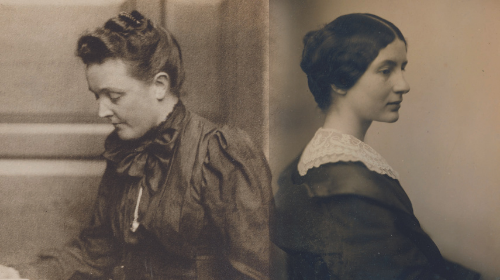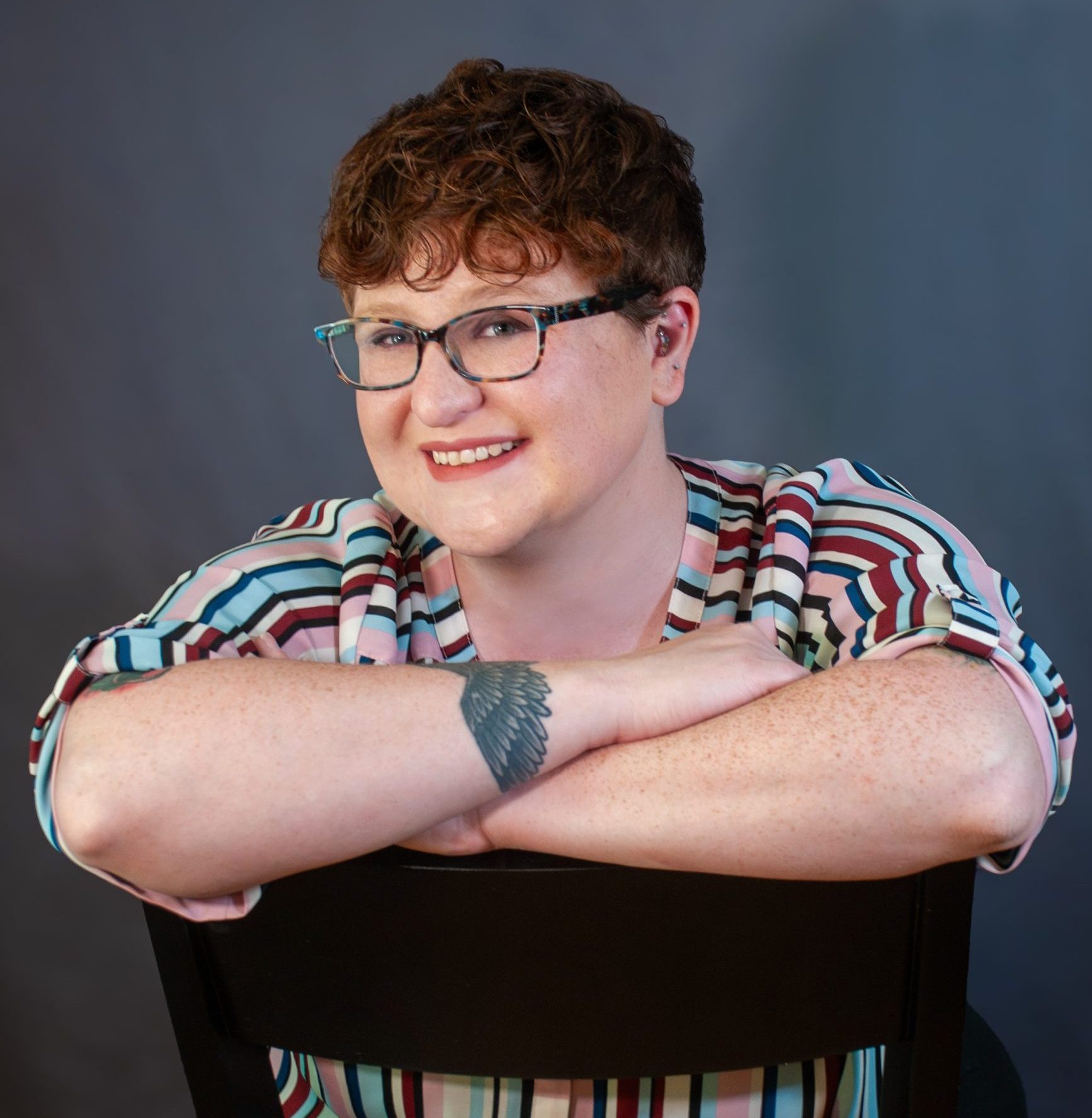
Queer people have always existed. However, the conversation surrounding how we talk about queer people in history is evolving.
What constitutes “proof” of a queer identity or relationship? What are the ethics of “outing” a historical figure? How do we leave room for queer possibility?
This three part series explores the challenges and opportunities of exploring queer history.
Part 1: Burden of Proof
For nearly three decades, interpretation at the the Sarah Orne Jewett House, a historic home operated by Historic New England, centered around Sarah as an author and highlighted her eclectic interior decorating style. The interpretation failed to mention Annie Fields, a woman with whom Sarah lived with in Boston for over twenty years.
For decades, historians considered that Annie and Sarah may have been in a sapphic relationship (see Note on Language). In writing to one another, Fields would refer to the Boston home that Sarah lived in with her as “our home.” Their letters reveal pet names for each other, mention physical affection, and reveal deep feelings of companionship.
However, this was deemed a “Boston Marriage,” a close friendship between unmarried women that was not necessarily a sapphic relationship, reinforcing the Victorian Era stereotype that women did not have sexual or romantic desire.
Best practice for most of the late 20th Century was that, unless there was definitive “proof” of romantic, physical same-gender relationship, historical subjects were not considered queer. This narrow view dismissed many relationships simply because physical attraction was not documented, as well as puts inappropriate focus on sex as the essential, if not only, qualifier of being queer.
Throughout the early 2000s, biographers, scholars, and Historic New England staff began thinking more critically about the information available about Sarah and Annie, strongly believing that they were in a sapphic relationship. In re-examining the archives, there were indicators of a romantic partnership. Photographs of Sarah’s bedroom as she left it showed that this was clearly a space that was shared with Annie Fields. A photograph of Annie was predominantly displayed about the fireplace. In their letters, which they wrote to each other constantly, they express missing each other deeply when they were not living together in Boston. For Historic New England, these were significant indicators that Sarah and Annie were in a loving relationship, and this story has been incorporated throughout the Jewett House interpretation since 2018.
In other circumstances, the “proof” simply does not exist. That within itself is the evidence of a queer relationship. This is especially relevant when we know a historical subject wrote extensively but, perhaps, their letters did not survive, long periods of time are missing from their journals, or sections of their journals are clearly removed or redacted.
Consider the surviving archival material of Emily Dickinson. The Emily Dickinson Museum estimates archives consist of only 10% of the letters the poet wrote in her lifetime. While some of the letters were likely discarded by the recipient, Emily explicitly directed that her letters from Susan (Gilbert) Dickinson be destroyed after her death.
A literary analysis of her poems and exchanges with her sister-in-law and childhood friend, reveals overtly romantic and sexual themes. However, the letters as physical objects are also revealing. Firstly, why would Emily ask that her letters from Susan be destroyed? This request indicates that there may have been material Emily did not want her others to know about, possibly regarding their relationship.
Some portions of Emily’s letters to Susan, which Susan did preserve, have been cut out. The editors of her poems and letters sometimes changed a female pronoun to a male pronoun when expressing romantic sentiments. Susan’s name has been erased from some source material. Emily’s brother (and Susan’s husband) and sister controlled most of the poet’s materials after her death. It is likely that they may have made these decisions either to preserve Emily and Susan’s privacy out of respect, or risk of embarrassing the family (or both) (see Note on Editing Dickinson).
Like Sarah Orne Jewett and Annie Fields, Emily and Susan wrote to each other frequently, even about mundane matters, despite living across the street from each other. Susan also served as Emily’s primary confidante for feedback on her poems. After Emily’s death, Livinia tasked Susan with compiling all of Emily’s writings, a project which ultimately did not move quickly enough and was transferred to Mabel Loomis Todd. Together, the frequency of their letters, the emotional depth of their relationship, and Susan’s dedication to Emily even in death, matched with the themes of Emily’s poems.The mystery of missing or changed archival material indicate a likely sapphic relationship.
These examples demonstrate that we cannot consider objects and archival material in a vacuum. We must analyze materials individually and in relationship for indicators of queer relationships, rather than having a narrow focus solely on physical romantic “proof.”
Stay tuned for Part 2: Out of the Closet
Did that example spark some ideas for your museum or organization?
Let’s connect to make those ideas a reality! Book a Discovery Call today.


NOTE ON LANGUAGE: Our understanding of gender identity and sexual orientation has evolved over time. Some of the words we use today, like lesbian, transgender, or nonbinary, were not popular – or even existed – in certain periods of history.
I have elected to use the term “sapphic” to describe people who were perceived as women throughout the majority of their lives and had emotional and/or physical romantic relationships with other people who identified as women throughout a majority of their lives. This includes people who we may today understand as nonbinary or transmasculine, but identified or were perceived as women in their time.
Regarding people who may have been nonbinary or transgender in the contemporary understanding of gender identity, I use the word “gender non-confirming.” This includes people who were known to “cross dress” by wearing clothing considered appropriate for a gender other than that which they were assigned at birth. In some cases, these individuals were doing this to express their nonbinary or transgender gender identity, but may not always have been the case.
NOTE ON EDITING DICKINSON: Austin Dickinson’s mistress Mabel Loomis Tood also played a central role in compiling, editing, and publishing Emily’s poems. Erasing Susan from Emily’s story de-centers her lover’s wife, Susan, as well as creates a more compelling brand of Emily as a recluse. These possibilities also play a large role in understanding why Emily’s letters and poems have been edited in this way.
BIBLIOGRAPHY:
Baim, Tracy. “Sex, Love, and Relationships.” LGBTQ America: A Theme Study of Lesbian, Gay, Bisexual, Transgender, and Queer History. National Parks Service. 2016.
Biscoff, Libby. “The Mantle of Love and Friendship.” Historic New England, Fall 2018.
Daly, Marilyn Keith, Sam Dinnie, and Ali Kane, Case Study Interview, March 22, 2024.
Dinnie, Sam, Peter Gittleman, and Ali Kane. Case Study Interview, March 18, 2024
Hart, Ellen Louise, and Martha Nell Smith, eds. Open Me Carefully: Emily Dickinson’s Intimate Letters to Susan Huntington Dickinson. Ashfield, Massachusetts: Paris Press, 1998.
Kane, Ali, Sam Dinnie, and Gwen Whiting. Case Study Interview. Personal, February 27, 2024.
Kane, Ali, Sam Dinnie, and Gwen Whiting. Introductory Call. Personal, May 7, 2024.
Streitmatter, Rodger. “The Ethics of Historical Outing.” June 5, 2013. Beacon Broadside. https://www.beaconbroadside.com/broadside/2013/06/the-ethics-of-historical-outing.html
Turino, Kenneth C. “The Varied Telling of Queer History at Historic New England Sites.” Essay. In Interpreting LGBT History at Museums and Historic Sites, 131–39. Lanham, MD: Rowman & Littlefield Publishers, 2014.

Love this blog!